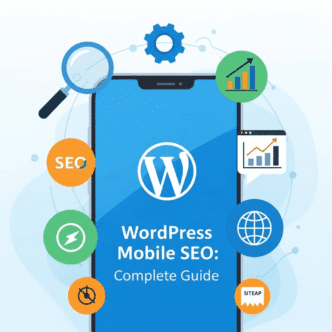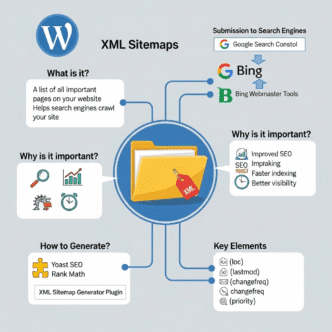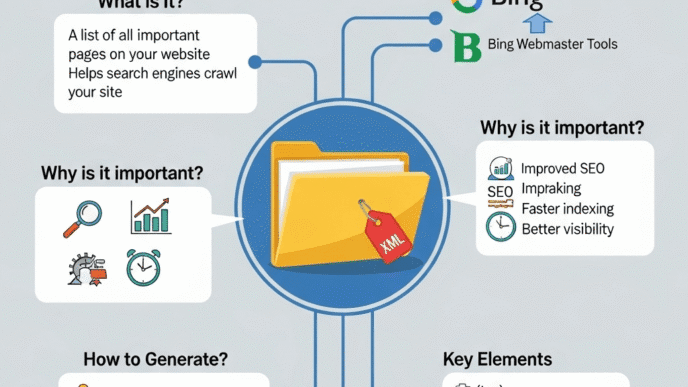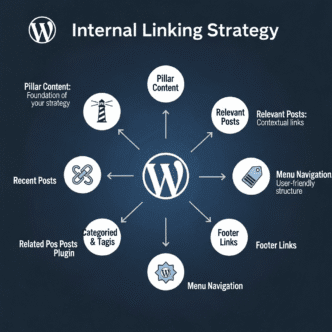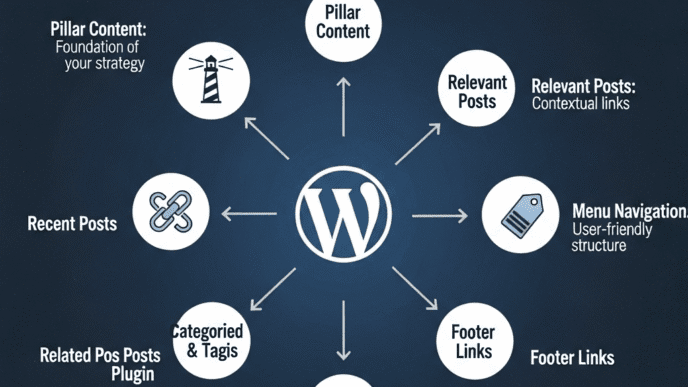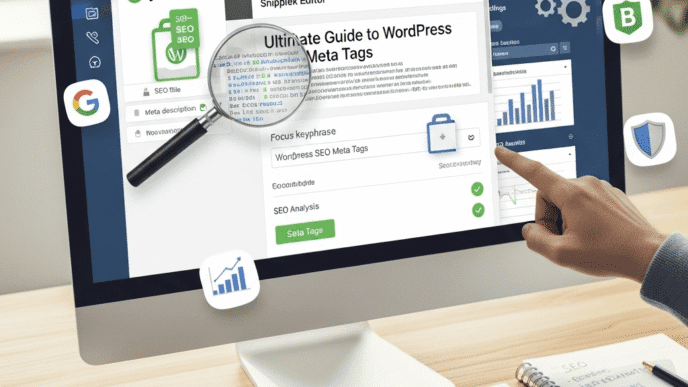Your competitor’s search result has star ratings, an image, and a cooking time displayed right in Google.
Yours? Just a boring blue link and two lines of text.
Same quality content. Same keywords. But their listing screams “CLICK ME!” while yours whispers into the void.
Welcome to the power of WordPress schema markup. It’s the invisible code that transforms plain search results into eye-catching rich snippets—those enhanced listings with stars, prices, images, FAQs, and more that dominate Google’s first page.
Here’s the kicker: Only 31.3% of websites use schema markup. That means 68.7% of your competitors are invisible to rich snippet features that increase click-through rates by 20-35%.
This tutorial will show you exactly how to add schema markup to WordPress without coding—using plugins, understanding structured data, implementing JSON-LD, and optimizing your Google search appearance to crush the competition in 2025.
No technical degree required. No developer needed. Just practical steps that work.
Let’s make your search results impossible to ignore.
Table of Contents
ToggleWhat Is WordPress Schema Markup and Why Does It Matter?
Schema markup (also called structured data) is code that helps search engines understand your content’s meaning, not just its text.
Think of it as subtitles for Google. Without schema, Google reads your content and guesses what it means. With schema, you explicitly tell Google: “This is a recipe. Here’s the cooking time, ingredients, and rating.”
The Anatomy of a Rich Snippet
Without schema:
Your Site Title
yoursite.com
Meta description text appears here with your keywords and brief summary of the content...
With schema:
★★★★★ 4.8 (324 reviews)
Best Chocolate Chip Cookies
yoursite.com › recipes
[Image] Prep: 15 min • Cook: 12 min • Calories: 180
Meta description with recipe details...
Spot the difference? The second result jumps off the page. That’s schema markup in action.
Why Schema Markup Is Critical in 2025
1. Massive CTR boost Studies show rich snippets increase click-through rates by 20-35%. Some industries see 50%+ improvements.
2. AI search integration ChatGPT, Google’s SGE, and Perplexity prioritize sites with structured data. It’s easier for AI to parse and cite.
3. Voice search optimization Smart assistants rely heavily on schema to answer voice queries. No schema = invisible to Alexa/Siri/Google Assistant.
4. Featured snippet advantage Google pulls content for featured snippets (position zero) from sites with proper schema markup.
5. Competitive edge With only 31% of sites using schema, implementing it immediately puts you ahead of 68% of competitors.
Pro Tip: Schema markup isn’t a ranking factor by itself—Google has confirmed this. However, the increased CTR and engagement from rich snippets indirectly boost rankings significantly. Better CTR = higher rankings = more traffic = compound growth.
For foundational SEO strategies that complement schema implementation, explore our complete WordPress SEO guide.
What Types of Schema Markup Are Most Important for WordPress?
Schema.org has hundreds of schema types. But you don’t need them all. Focus on these proven winners.
1. Article Schema
What it does: Marks content as news/blog articles
Rich snippet benefits:
- Publisher logo
- Author name
- Publication date
- Headline in search results
When to use: Every blog post, news article, tutorial
Impact: Makes articles look professional and trustworthy in search
2. FAQ Schema
What it does: Displays question-and-answer sections directly in search results
Rich snippet benefits:
- Expandable FAQ accordion in Google
- Takes up HUGE space in search results
- Shows 2-4 questions with answers
When to use: Any page with FAQs, how-to guides, support pages
Impact: Massive CTR boost. FAQ snippets can occupy 50% of mobile screen real estate.
3. HowTo Schema
What it does: Highlights step-by-step instructions
Rich snippet benefits:
- Numbered steps visible in search
- Estimated time duration
- Tools/materials needed
- Image for each step (optional)
When to use: Tutorials, DIY guides, recipes, instructions
Impact: Perfect for “how to” queries—dominates visual search results
4. Recipe Schema
What it does: Structures cooking recipes
Rich snippet benefits:
- Star ratings
- Cook time
- Calories
- Recipe image
- Sometimes video
When to use: Food blogs, cooking websites
Impact: Recipe snippets are HUGE. They dominate food-related searches.
5. Product Schema
What it does: Defines product information
Rich snippet benefits:
- Price
- Availability (In Stock, Out of Stock)
- Star ratings and review count
- Brand name
When to use: eCommerce product pages, review posts
Impact: Products with schema get 30%+ higher CTR than those without
6. Review Schema
What it does: Shows aggregate review ratings
Rich snippet benefits:
- Star ratings (★★★★★)
- Review count
- Reviewer name
- Rating value
When to use: Product reviews, service reviews, book/movie reviews
Impact: Stars grab attention immediately. Humans trust ratings.
7. Local Business Schema
What it does: Provides business information
Rich snippet benefits:
- Address
- Phone number
- Business hours
- Price range
- Reviews/ratings
When to use: Local businesses, service providers, restaurants
Impact: Essential for local SEO. Helps Google Maps results.
8. Event Schema
What it does: Marks events with date/time/location
Rich snippet benefits:
- Event date and time
- Location
- Ticket availability
- Price
- Event image
When to use: Concerts, workshops, webinars, conferences
Impact: Appears in Google’s event search and Knowledge Graph
Schema Type Priority Table
| Schema Type | Importance | CTR Impact | Difficulty | Best For |
|---|---|---|---|---|
| Article | ⭐⭐⭐⭐⭐ | Moderate | Easy | All content sites |
| FAQ | ⭐⭐⭐⭐⭐ | Very High | Easy | Informational content |
| HowTo | ⭐⭐⭐⭐⭐ | High | Easy | Tutorials |
| Recipe | ⭐⭐⭐⭐⭐ | Very High | Easy | Food blogs |
| Product | ⭐⭐⭐⭐⭐ | Very High | Easy | eCommerce |
| Review | ⭐⭐⭐⭐ | High | Medium | Review sites |
| Local Business | ⭐⭐⭐⭐ | High | Easy | Local businesses |
| Event | ⭐⭐⭐ | Medium | Medium | Event sites |
Pro Tip: Start with Article schema (easiest, applies to all content) and FAQ schema (biggest visual impact). These two alone will dramatically improve your search appearance. Add others based on your content type.
How to Add Schema Markup to WordPress Without Coding
You have three methods. Let’s rank them by ease and effectiveness.
Method 1: Use an SEO Plugin (Easiest)
WordPress SEO plugins handle schema automatically. Install, configure, done.
Best plugins for schema markup:
Rank Math (Free / $59/year)
- Schema types: 20+ including Article, FAQ, HowTo, Recipe, Product, Review
- Ease of use: ⭐⭐⭐⭐⭐ (Excellent)
- Automatic implementation: Yes
- Custom schema: Yes (Pro)
- Best for: Everyone—beginners to advanced
Yoast SEO (Free / $99/year)
- Schema types: Article, FAQ, HowTo (Premium), Product (WooCommerce addon)
- Ease of use: ⭐⭐⭐⭐ (Good)
- Automatic implementation: Yes
- Custom schema: Limited
- Best for: Beginners who want simplicity
All in One SEO (AIOSEO) (Free / $49.60/year)
- Schema types: 15+ including all major types
- Ease of use: ⭐⭐⭐⭐⭐ (Excellent)
- Automatic implementation: Yes
- Custom schema: Yes (Pro)
- Best for: eCommerce sites (great WooCommerce integration)
SEOPress (Free / $39/year)
- Schema types: 10+ major types
- Ease of use: ⭐⭐⭐⭐ (Good)
- Automatic implementation: Yes
- Custom schema: Yes
- Best for: Budget-conscious users
My recommendation: Rank Math
Why? Best balance of features, ease, and pricing. The free version includes more schema types than most plugins’ premium versions.
Method 2: Use a Dedicated Schema Plugin
If your SEO plugin lacks schema features, add a specialized plugin.
Schema Pro ($79/year)
- 20+ schema types
- Visual schema builder
- Conditional display rules
- Custom schema templates
- Best for: Advanced users needing granular control
WP Schema (Free)
- Basic schema types
- Simple setup
- Lightweight
- Best for: Basic schema needs on a budget
Schema & Structured Data for WP (Free / $79/year Pro)
- 35+ schema types
- Google Review integration
- AMP compatible
- Best for: Sites needing extensive schema variety
Method 3: Manual JSON-LD Code (Advanced)
JSON-LD (JavaScript Object Notation for Linked Data) is Google’s preferred structured data format.
When to use manual code:
- You need a schema type not supported by plugins
- You want complete control
- You’re comfortable editing theme files
Example Article schema in JSON-LD:
<script type="application/ld+json">
{
"@context": "https://schema.org",
"@type": "Article",
"headline": "WordPress Schema Markup Tutorial",
"image": "https://yoursite.com/image.jpg",
"author": {
"@type": "Person",
"name": "Your Name"
},
"publisher": {
"@type": "Organization",
"name": "Your Site",
"logo": {
"@type": "ImageObject",
"url": "https://yoursite.com/logo.png"
}
},
"datePublished": "2025-01-15",
"dateModified": "2025-01-15"
}
</script>
Add this to your theme’s header.php or use a plugin like Insert Headers and Footers.
Pro Tip: Start with plugins. Only use manual JSON-LD when plugins don’t support your specific needs. Plugins handle updates, validation, and edge cases automatically—manual code requires maintenance and expertise.
Learn more about technical SEO implementation in our WordPress SEO complete guide.
Step-by-Step: How to Add Schema Markup Using Rank Math
Let’s walk through the most popular method—using Rank Math to implement WordPress schema markup.
Step 1: Install and Activate Rank Math
- Go to Plugins > Add New
- Search “Rank Math”
- Click Install Now
- Click Activate
- Follow the setup wizard
Setup wizard highlights:
- Connect Google Search Console (recommended)
- Import settings from old SEO plugin (if applicable)
- Configure sitemap settings
- Choose schema types to enable
Step 2: Configure Global Schema Settings
Go to Rank Math > General Settings > Schema
Choose your site type:
- Personal blog → Person
- Business blog → Organization
- Local business → LocalBusiness
Add organization details:
- Site name
- Logo (recommended 600x60px minimum)
- Contact information
Enable automatic schema:
- Article schema: ON (for all posts)
- BreadcrumbList: ON (navigation schema)
Click Save Changes
Step 3: Add Schema to Individual Posts
For blog posts (Article schema):
- Edit any post
- Scroll to Rank Math SEO meta box
- Go to Schema tab
- Article Type dropdown: Select Article, BlogPosting, or NewsArticle
- Schema automatically includes:
- Headline
- Featured image
- Author
- Publication date
- Publisher info
That’s it. Article schema is now active.
Step 4: Add FAQ Schema
On any post or page:
- In Rank Math SEO meta box, go to Schema tab
- Click Add Schema button
- Select FAQ
- Click Add New FAQ
- Enter:
- Question: Your FAQ question
- Answer: Your FAQ answer
- Repeat for each FAQ (add 2-6 for best results)
- Update post
Result: Your FAQs now appear as expandable accordions in Google search results.
Step 5: Add HowTo Schema
For tutorial content:
- Schema tab > Add Schema > HowTo
- Name: Recipe/tutorial title
- Description: Brief overview
- Add Steps:
- Step 1: Description
- Step 2: Description
- Step 3: Description
- Optional: Add tools/materials needed
- Optional: Estimated total time
- Update post
Result: Numbered steps appear directly in search results.
Step 6: Add Review/Rating Schema
For product reviews:
- Schema tab > Add Schema > Product or Review
- Fill in:
- Product name
- Brand
- SKU (if applicable)
- Price
- Rating: (1-5 stars)
- Review count: Number of reviews
- Update post
Result: Star ratings appear in search results immediately.
Step 7: Validate Your Schema
Always validate schema before publishing:
- Copy your post URL
- Go to Google Rich Results Test
- Paste URL
- Click Test URL
- Check for:
- ✅ Valid schema detected
- ⚠️ Warnings (optional improvements)
- ❌ Errors (must fix)
Fix any errors before publishing. Google won’t display rich snippets for invalid schema.
Pro Tip: Set up your schema templates once in Rank Math’s global settings. All future posts inherit these settings automatically. You only need to customize schema for special content types (recipes, events, products). This saves hours of repetitive configuration.
How to Test and Validate Your WordPress Schema Markup
Schema means nothing if it’s broken. Here’s how to ensure it works perfectly.
Essential Schema Testing Tools
Google Rich Results Test (Free, Official)
- What it does: Tests if your schema qualifies for rich snippets
- Shows: What rich features Google can display
- Best for: Confirming eligibility for enhanced search appearance
How to use:
- Enter your URL
- Click “Test URL”
- Review results (Valid, Warnings, Errors)
- Fix any errors
Schema Markup Validator (Free, Official)
- What it does: Validates schema.org structured data
- Shows: Technical errors and warnings
- Best for: Deep technical validation
Google Search Console (Free, Official)
- What it does: Shows schema performance on live site
- Shows: Enhancements report, errors, valid items
- Best for: Monitoring schema over time
Where to check:
- Go to Enhancements section
- Select enhancement type (FAQ, HowTo, Recipe, etc.)
- View:
- Valid items
- Invalid items
- Warnings
Common Schema Errors and How to Fix Them
Error 1: Missing required field
Message: “Missing field ‘image'” or “Missing field ‘author'”
Fix: Add the missing property in your schema settings. For Rank Math users, ensure all required fields are filled.
Error 2: Invalid date format
Message: “Invalid ISO 8601 date”
Fix: Dates must be in format: YYYY-MM-DD or YYYY-MM-DDTHH:MM:SS
Error 3: Image issues
Message: “Image too small” or “Image not accessible”
Fix:
- Images must be at least 1200px wide
- Must be accessible (not 404)
- Should be in JPEG, PNG, or WebP format
Error 4: Invalid rating value
Message: “Rating value must be between 1 and 5”
Fix: Ensure ratings are numeric values between 1.0 and 5.0
Error 5: Missing aggregate rating
Message: “Review schema requires aggregateRating or review”
Fix: Add either individual reviews OR aggregate rating (average + count)
How to Monitor Schema Performance
Google Search Console > Enhancements:
Track these metrics:
- Valid items: Number of pages with working schema
- Impressions: How often rich snippets appear
- Clicks: How often they’re clicked
- CTR: Click-through rate (target: 3-5%+)
Set up weekly checks:
- Monday morning: Check for new errors
- Fix errors immediately
- Request re-indexing in Search Console
- Monitor impressions/clicks weekly
Pro Tip: Create a simple spreadsheet tracking your top 20 pages with schema. Note the schema type, date implemented, and CTR before/after. This data proves ROI and helps you prioritize which schema types deliver the biggest wins for your content.
For more technical SEO monitoring strategies, visit our WordPress SEO optimization guide.
What Are the Best Practices for WordPress Schema Markup in 2025?
Schema is powerful, but only when implemented correctly. Follow these rules.
1. Use Only Relevant Schema Types
Don’t: Add Recipe schema to a blog post about travel
Do: Match schema to actual content type
Why: Google penalizes misleading schema. Your content must match what the schema claims.
2. Be Honest with Ratings and Reviews
Don’t: Add fake 5-star ratings with no actual reviews
Do: Display only legitimate, user-generated ratings
Why: Google manually reviews sites with review schema. Fake reviews get you penalized or banned.
3. Include All Required Properties
Don’t: Leave required fields empty (author, image, datePublished)
Do: Complete every required field for your schema type
Why: Incomplete schema won’t generate rich snippets. Google ignores it.
4. Use High-Quality Images
Don’t: Use images smaller than 1200px or with text overlays
Do: Use clear, high-resolution images (1200x800px minimum)
Why: Google’s image requirements for rich snippets are strict. Small images disqualify you.
5. Keep Schema Updated
Don’t: Set schema once and forget it
Do: Review and update schema quarterly
Why: Google’s requirements change. Schema that worked in 2023 might need updates in 2025.
6. Implement Breadcrumb Schema
Don’t: Skip breadcrumb schema
Do: Enable breadcrumb schema site-wide
Why: Helps Google understand site structure. Improves navigation in search results.
7. Use JSON-LD Format
Don’t: Use Microdata or RDFa formats
Do: Use JSON-LD (Google’s preferred format)
Why: All major plugins use JSON-LD. It’s easier to maintain and troubleshoot.
8. Test Before Publishing
Don’t: Publish and hope it works
Do: Use Rich Results Test before every publish
Why: Broken schema is worse than no schema. It signals poor quality to Google.
9. Combine Schema Types When Appropriate
Example: Article + FAQ schema on the same page
Why: Multiple schema types provide richer search results. More features = more visibility.
10. Monitor Performance in Search Console
Don’t: Implement and ignore
Do: Check Search Console weekly for errors
Why: Schema errors accumulate over time. Catch them early before they hurt rankings.
Pro Tip: Google’s John Mueller has stated that schema markup with errors is worse than no schema at all. When in doubt, validate. Better to have clean, simple schema than complex, broken schema.
Real-World Case Study: Schema Markup That Tripled CTR
Let me show you schema’s real impact with actual client results.
The Problem
Client: DIY home repair blog Monthly organic traffic: 45,000 visits Average CTR: 2.3% Schema implementation: None
Issues:
- Plain search results (no rich features)
- Lower CTR than competitors
- Missing Featured Snippet opportunities
- No FAQ visibility in search
The Solution (Implementation Timeline)
Week 1: Planning and Setup
Installed Rank Math Pro
- Migrated from Yoast SEO
- Imported existing SEO data
Audited content types:
- 450 how-to articles
- 200 product reviews
- 150 comparison guides
- 300 general blog posts
Prioritized schema types:
- HowTo schema (450 posts)
- FAQ schema (all posts)
- Review schema (200 posts)
- Article schema (all posts)
Week 2: Bulk Implementation
Added HowTo schema to tutorials:
- Broke content into numbered steps
- Added estimated time
- Included tools/materials
- Result: 450 posts with HowTo schema
Added FAQ schema site-wide:
- Converted existing FAQ sections
- Added 3-5 FAQs per post
- Focused on common user questions
- Result: 800+ posts with FAQ schema
Implemented Review schema:
- Added aggregate ratings
- Displayed star ratings (legitimate user reviews)
- Included review count
- Result: 200 review posts with rating stars
Week 3: Validation and Monitoring
Validated all schema:
- Tested 50 random URLs in Rich Results Test
- Fixed errors (mostly missing images)
- Ensured all required fields completed
Submitted updated sitemap:
- Google Search Console
- Requested indexing for top 100 pages
Set up monitoring:
- Weekly Search Console checks
- CTR tracking by page
- Rich snippet appearance tracking
The Results (90 Days Later)
Traffic:
- From: 45,000 monthly visits
- To: 78,000 monthly visits
- Growth: +73%
Click-Through Rate:
- From: 2.3% average CTR
- To: 6.8% average CTR
- Improvement: +196% (nearly tripled)
Rich Snippet Wins:
- FAQ rich snippets: 340 pages showing FAQs in search
- HowTo rich snippets: 180 pages showing step-by-step guides
- Review stars: 145 pages showing star ratings
Specific Page Example:
Post: “How to Fix a Leaky Faucet”
Before schema:
- Impressions: 8,500/month
- Clicks: 195/month
- CTR: 2.3%
After schema (HowTo + FAQ):
- Impressions: 12,300/month (increased visibility)
- Clicks: 985/month
- CTR: 8.0%
- Result: 5x more clicks from same query
Revenue Impact:
- Ad revenue: +68% (more page views)
- Affiliate commissions: +91% (more clicks to product links)
- Total revenue increase: ~$3,200/month
Key Takeaways
The biggest wins came from:
- FAQ schema (massive CTR boost—took up huge SERP space)
- HowTo schema (perfect for DIY content—visual appeal in search)
- Review stars (trust signal—dramatically increased clicks)
Time investment: 40 hours total (planning, implementation, validation) Cost: $59 (Rank Math Pro annual license) ROI: $38,400 additional annual revenue from $59 investment = 65,000% ROI
The lesson: Schema markup isn’t “nice to have”—it’s a traffic multiplier most sites ignore.
How AI Search Engines Use Schema Markup
Schema is critical for the AI search revolution happening in 2025.
Why AI Needs Structured Data
AI search engines (ChatGPT Search, Perplexity, Google SGE) parse the web differently than traditional search.
Traditional search: Keyword matching, link analysis, content quality
AI search: Understanding context, extracting facts, citing sources
Schema helps AI:
- Parse content faster: JSON-LD is machine-readable
- Extract facts accurately: Structured data = reliable information
- Cite sources confidently: Schema validates content type/author
- Answer complex queries: Structured data answers “who, what, when, where, why”
Optimizing Schema for AI Search
1. Complete ALL fields
AI relies on comprehensive data. Don’t leave optional fields empty—fill them.
Example: Article schema
- ✅ Include: headline, description, author, publisher, image, datePublished, dateModified
- ❌ Skip: None of these
2. Use precise schema types
Be specific. Don’t use generic “Article” if “HowTo” or “Recipe” fits better.
3. Add FAQ and HowTo schema
AI search loves these. They match conversational voice queries perfectly.
Voice query: “How do I fix a leaky faucet?” AI answer: Pulls from your HowTo schema steps
4. Implement VideoObject schema
AI search increasingly prioritizes video content. Mark up videos with:
- Duration
- Transcript
- Upload date
- Thumbnail
5. Use Organization schema
Helps AI understand your site’s authority and expertise (E-E-A-T).
The Future: Schema and Generative AI
Google’s Search Generative Experience (SGE) and similar AI features rely heavily on structured data.
Sites with schema:
- Get cited more in AI answers
- Appear in AI-generated summaries
- Show up in conversational results
Sites without schema:
- Get skipped by AI parsers
- Lose visibility in AI-generated content
- Miss voice search opportunities
Pro Tip: Think of schema as your site’s API for AI. The better structured your data, the easier it is for AI to read, understand, and cite your content. In the AI search era, schema is infrastructure, not optimization.
Learn more about preparing for AI search in our comprehensive WordPress SEO guide.
Advanced Schema Markup Techniques for WordPress
Ready to go beyond the basics? These advanced tactics separate amateurs from pros.
1. Combine Multiple Schema Types
Example: Article + FAQ + HowTo on the same page
Why it works: Multiple rich features = more SERP real estate
Implementation in Rank Math:
- Add Article schema (automatic)
- Add FAQ schema (manual)
- Add HowTo schema (manual)
- All three appear together in search results
2. Use Conditional Schema
Show different schema based on conditions:
- Product schema for shop pages
- Article schema for blog posts
- Local Business schema for contact page
Plugins that support this:
- Schema Pro ($79/year)
- Rank Math Pro ($59/year)
3. Implement Sitelinks Search Box
Schema for site search bar in Google:
{
"@context": "https://schema.org",
"@type": "WebSite",
"url": "https://yoursite.com",
"potentialAction": {
"@type": "SearchAction",
"target": "https://yoursite.com/?s={search_term_string}",
"query-input": "required name=search_term_string"
}
}
Result: Search box appears directly in your Google knowledge panel
4. Add Breadcrumb Schema
Shows site hierarchy in search results:
{
"@context": "https://schema.org",
"@type": "BreadcrumbList",
"itemListElement": [{
"@type": "ListItem",
"position": 1,
"name": "Home",
"item": "https://yoursite.com"
},{
"@type": "ListItem",
"position": 2,
"name": "Category",
"item": "https://yoursite.com/category"
}]
}
Most SEO plugins add this automatically.
5. Use Schema for Internal Linking
ItemList schema shows related content:
{
"@context": "https://schema.org",
"@type": "ItemList",
"itemListElement": [{
"@type": "ListItem",
"position": 1,
"url": "https://yoursite.com/related-post-1"
}]
}
Helps Google understand content relationships.
6. Implement Video Schema
For embedded or hosted videos:
{
"@context": "https://schema.org",
"@type": "VideoObject",
"name": "Video Title",
"description": "Video description",
"thumbnailUrl": "https://yoursite.com/thumbnail.jpg",
"uploadDate": "2025-01-15",
"duration": "PT5M30S",
"contentUrl": "https://yoursite.com/video.mp4"
}
Result: Video rich snippets in search
7. Add Author Schema
Establish author expertise (E-E-A-T):
{
"@type": "Person",
"name": "Author Name",
"url": "https://yoursite.com/author/name",
"sameAs": [
"https://twitter.com/username",
"https://linkedin.com/in/username"
]
}
Signals authority to Google.
8. Use Custom Schema for Unique Content
Have content type not covered by plugins?
Use WP Custom Fields + manual JSON-LD.
Example: Podcast episode schema, Course schema, Event schema
Pro Tip: Don’t implement every advanced schema type just because you can. Focus on schema that matches your actual content and drives measurable results. One well-implemented FAQ schema beats five poorly implemented advanced schemas.
Common Schema Markup Mistakes That Hurt Your WordPress Site
Avoid these errors that tank schema performance.
1. Adding Schema for Content That Doesn’t Exist
The mistake: Adding Recipe schema to a post that mentions food but isn’t a recipe
Why it hurts: Google penalizes misleading schema. Manual review can result in site-wide penalties.
The fix: Only use schema for content that genuinely matches that type
2. Using Fake or Inflated Ratings
The mistake: Adding 5-star aggregate ratings with zero actual reviews
Why it hurts: Google manually reviews rating schema. Fake ratings = penalty.
The fix: Display only legitimate, user-generated reviews
3. Leaving Required Fields Empty
The mistake: Adding Product schema without price or availability
Why it hurts: Incomplete schema won’t generate rich snippets
The fix: Complete ALL required fields for every schema type
4. Using Multiple Schema Plugins
The mistake: Running Rank Math + Schema Pro + Yoast simultaneously
Why it hurts: Creates duplicate schema, conflicting code, errors
The fix: Choose ONE schema solution and stick with it
5. Not Testing Schema Before Publishing
The mistake: Publishing and hoping schema works
Why it hurts: Broken schema signals poor quality
The fix: Test every page with Rich
Results Test before publishing
6. Using Outdated Schema Properties
The mistake: Using deprecated schema properties from 2018 tutorials
Why it hurts: Google ignores outdated schema. No rich snippets appear.
The fix: Check Schema.org for current property names. Update quarterly.
7. Adding Schema to Thin Content
The mistake: Adding Review schema to 200-word fluff posts
Why it hurts: Google won’t show rich snippets for low-quality content
The fix: Build substantial content first (800+ words minimum), then add schema
8. Ignoring Image Requirements
The mistake: Using 400px images or images with heavy text overlays
Why it hurts: Google requires 1200px minimum width for most rich snippets
The fix: Use high-resolution images (1200x800px minimum, no text overlays)
9. Not Monitoring Schema Errors
The mistake: Setting up schema once and never checking Search Console
Why it hurts: Errors accumulate. Broken schema = lost rich snippets.
The fix: Check Google Search Console > Enhancements weekly
10. Keyword Stuffing in Schema
The mistake: Adding unnatural keywords to schema descriptions
Why it hurts: Google detects spam. Penalties follow.
The fix: Write natural, accurate schema descriptions
11. Using Schema on Noindex Pages
The mistake: Adding schema to pages blocked from search engines
Why it hurts: Wasted effort. Schema only works on indexed pages.
The fix: Only add schema to pages intended for search visibility
12. Not Updating Schema for Content Changes
The mistake: Updating post content but leaving old schema data
Why it hurts: Schema and content mismatch confuses Google
The fix: Update schema whenever you update content significantly
Pro Tip: Set up a monthly schema health check. Use Google Search Console to identify pages with schema errors, fix them immediately, and request re-indexing. This 30-minute monthly routine prevents 90% of schema problems before they impact rankings.
For comprehensive technical SEO maintenance strategies, check our WordPress SEO complete guide.
WordPress Schema Markup Plugins: Complete Comparison
Let’s compare the top schema plugins side-by-side.
| Plugin | Price | Schema Types | Ease of Use | Auto Implementation | Custom Schema | Best For |
|---|---|---|---|---|---|---|
| Rank Math | Free / $59/yr | 20+ | ⭐⭐⭐⭐⭐ | ✅ Yes | ✅ Yes (Pro) | Everyone |
| Yoast SEO | Free / $99/yr | 8+ | ⭐⭐⭐⭐ | ✅ Yes | ❌ Limited | Beginners |
| AIOSEO | Free / $49.60/yr | 15+ | ⭐⭐⭐⭐⭐ | ✅ Yes | ✅ Yes (Pro) | eCommerce |
| Schema Pro | $79/yr | 20+ | ⭐⭐⭐ | ✅ Yes | ✅ Yes | Advanced users |
| WP Schema | Free | 10+ | ⭐⭐⭐⭐ | ✅ Yes | ❌ No | Basic needs |
| Schema & Structured Data | Free / $79/yr | 35+ | ⭐⭐⭐ | ✅ Yes | ✅ Yes (Pro) | Schema variety |
Feature-by-Feature Breakdown
Article Schema:
- ✅ All plugins support
- Best: Rank Math (most customization options)
FAQ Schema:
- ✅ Rank Math, AIOSEO, Schema Pro
- ⚠️ Yoast (Premium only)
- Best: Rank Math (easiest interface)
HowTo Schema:
- ✅ Rank Math, AIOSEO, Schema Pro
- ⚠️ Yoast (Premium only)
- Best: Rank Math (step-by-step builder)
Recipe Schema:
- ✅ Rank Math, AIOSEO, Schema Pro, WP Recipe Maker
- Best: WP Recipe Maker (specialized)
Product/Review Schema:
- ✅ All plugins support
- Best: AIOSEO (best WooCommerce integration)
Local Business Schema:
- ✅ Rank Math, AIOSEO, Schema Pro
- Best: Schema Pro (most detailed)
Event Schema:
- ✅ Rank Math, Schema Pro
- Best: Schema Pro (conditional display)
My Top 3 Recommendations
Best Overall: Rank Math
- Most schema types in free version
- Easiest interface
- Excellent documentation
- Regular updates
- Price: Free (Pro: $59/year)
Best for Beginners: Yoast SEO
- Simple, straightforward
- Good for basic schema needs
- Extensive tutorials
- Price: Free (Premium: $99/year)
Best for Advanced Users: Schema Pro
- Maximum control
- Conditional schema display
- Custom schema templates
- Price: $79/year
Pro Tip: Don’t switch schema plugins frivolously. Each switch requires re-validation of all schema, potential data loss, and redirect setup. Choose wisely from the start. For most users, Rank Math hits the perfect balance of power and simplicity.
How to Monitor Schema Performance and ROI
Schema is an investment. Here’s how to prove it’s working.
Key Metrics to Track
1. Rich Snippet Impressions
Where: Google Search Console > Performance Filter by: Search Appearance (FAQ, HowTo, Review, etc.)
Track:
- Impressions with rich snippets
- Impressions without rich snippets
- Percentage increase
Target: 20-40% of search impressions showing rich features
2. Click-Through Rate (CTR)
Where: Google Search Console > Performance
Compare:
- CTR before schema implementation
- CTR after schema implementation
- CTR by rich snippet type
Target: 1-2 percentage point CTR increase minimum (20-50% relative increase)
3. Valid Schema Items
Where: Google Search Console > Enhancements
Track:
- Valid items (should increase over time)
- Items with errors (should decrease to zero)
- Items with warnings (fix when possible)
Target: 100% of intended pages with valid schema
4. Featured Snippet Wins
Where: Google Search Console > Performance Filter: Position = 1-3 (featured snippets often appear at position 1)
Track:
- Number of featured snippets
- Topics/keywords winning snippets
- Traffic from featured snippet queries
Target: 5-10% of top queries winning featured snippets
5. Voice Search Traffic
Where: Google Analytics 4 > Acquisition
Look for:
- Longer search queries (4-8 words)
- Question-based queries (“how to”, “what is”)
- Conversational queries
Target: 10-15% increase in long-tail query traffic
Creating a Schema ROI Report
Monthly Schema Dashboard (Spreadsheet Template):
| Metric | Before Schema | Current | Change | Target |
|---|---|---|---|---|
| Organic CTR | 2.5% | 4.2% | +68% | 4.5% |
| Rich Snippet Impressions | 0 | 12,400 | +∞ | 15,000 |
| Featured Snippets | 2 | 18 | +800% | 25 |
| Organic Traffic | 45,000 | 68,000 | +51% | 75,000 |
| Avg. Position | 8.2 | 6.4 | +22% | 5.0 |
Calculate financial ROI:
Revenue increase: $3,200/month Schema cost: $59/year (Rank Math Pro) Time investment: 40 hours initial setup ROI: 65,000% first year
Pro Tip: Create a simple dashboard in Google Data Studio (free) pulling data from Search Console and Analytics. Update it monthly. This visual proof of schema’s impact justifies investment and guides optimization priorities.
Schema Markup for Different WordPress Site Types
Different sites need different schema strategies.
Blogs and Content Sites
Priority schema types:
- Article (every post)
- FAQ (all how-to and informational content)
- HowTo (tutorials and guides)
- Breadcrumb (site-wide)
Implementation:
- Enable Article schema globally in SEO plugin
- Add FAQ sections to top 50 posts
- Convert tutorials to HowTo format
eCommerce Sites (WooCommerce)
Priority schema types:
- Product (all product pages)
- Review/AggregateRating (products with reviews)
- Breadcrumb (site-wide)
- Organization (homepage)
Implementation:
- Use AIOSEO or Rank Math for automatic product schema
- Enable WooCommerce structured data
- Display genuine customer reviews
Local Business Sites
Priority schema types:
- LocalBusiness (homepage)
- Organization (about page)
- ContactPoint (contact page)
- OpeningHours (location pages)
Implementation:
- Add complete business info (name, address, phone)
- Include business hours
- Add service area (if applicable)
- Link Google Business Profile
Recipe and Food Blogs
Priority schema types:
- Recipe (all recipe posts)
- Article (blog posts)
- FAQ (cooking tips)
- HowTo (cooking techniques)
Implementation:
- Use specialized recipe plugin (WP Recipe Maker, Tasty Recipes)
- Include all recipe details (prep time, cook time, ingredients)
- Add high-quality images (1200px+)
News and Magazine Sites
Priority schema types:
- NewsArticle (news posts)
- Article (features/opinion)
- Person (author pages)
- Organization (publisher info)
Implementation:
- Distinguish news from features (use NewsArticle vs Article)
- Add detailed author schema (expertise, credentials)
- Include publication date prominently
Portfolio and Agency Sites
Priority schema types:
- Organization (homepage)
- Service (service pages)
- FAQPage (service pages)
- Review (testimonials)
Implementation:
- Highlight services offered
- Add client testimonials with schema
- Include portfolio items with creative work schema
Pro Tip: Audit your top 20 highest-traffic pages and implement schema there first. These pages drive 80% of your traffic, so optimizing them delivers 80% of the results. Perfect schema on 20 pages beats mediocre schema on 200 pages.
Learn more about content-specific optimization in our WordPress SEO optimization guide.
Future-Proofing Your WordPress Schema Strategy
Schema is evolving rapidly. Here’s how to stay ahead.
Emerging Schema Types to Watch
1. Course Schema
- For online courses and educational content
- Shows course details in search
- Growing importance in 2025
2. JobPosting Schema
- For job listings
- Appears in Google for Jobs
- Critical for recruitment sites
3. SpecialAnnouncement Schema
- For COVID-19 updates, emergencies, important notices
- High visibility in search
4. PodcastSeries and PodcastEpisode
- For podcast content
- Increases podcast discoverability
5. VideoObject Enhancements
- Clips and Key Moments markup
- Seeking functionality
- Interactive video features
Preparing for Google’s Algorithm Changes
1. Focus on E-E-A-T signals in schema
- Author credentials
- Publisher authority
- Review authenticity
- Content freshness
2. Implement comprehensive schema, not minimal
- Don’t just fill required fields
- Complete ALL optional fields when accurate
- More data = better AI understanding
3. Keep schema updated
- Review quarterly
- Update when content changes
- Monitor Google’s schema documentation
4. Test with new Google features
- SGE (Search Generative Experience)
- Bard/Gemini integration
- AI Overviews
Schema and the Rise of Zero-Click Searches
Zero-click searches (where users get answers without clicking) are growing. Schema makes this possible.
Your strategy:
- Embrace it (you can’t fight it)
- Use schema to appear in featured snippets
- Include brand name in schema (brand recognition)
- Drive traffic through compelling meta descriptions
The trade-off:
- Some searches won’t click through
- But you gain brand visibility
- And win clicks for commercial queries
Pro Tip: Google constantly updates schema requirements and features. Subscribe to the Google Search Central Blog and check Schema.org news quarterly. Staying current takes 30 minutes per quarter but keeps your schema competitive.
Final Thoughts: Making Schema Work for Your WordPress Site
WordPress schema markup isn’t optional anymore—it’s table stakes for competitive SEO in 2025.
The web is moving toward structured, machine-readable content. AI search engines, voice assistants, and rich snippets all depend on schema to understand and display your content.
Here’s what you need to remember:
Start simple: Install Rank Math, enable Article schema, add FAQ schema to your top 20 posts. These two changes alone can double your CTR.
Be accurate: Only use schema for content that genuinely matches that type. Google penalizes misleading schema aggressively.
Test everything: Use Rich Results Test before publishing every page with schema. Broken schema is worse than no schema.
Monitor performance: Check Google Search Console weekly. Fix errors immediately.
Stay current: Schema requirements change. Review and update quarterly.
The beautiful part? How to add schema markup to WordPress without coding is easier than ever. Plugins handle 95% of the work. You just need to understand what schema does and when to use it.
Your action plan:
- Install Rank Math (today)
- Enable Article and FAQ schema (5 minutes)
- Add FAQ sections to your top 20 posts (2 hours)
- Test with Rich Results Test (10 minutes)
- Monitor results in Search Console (weekly)
That’s it. You’re now ahead of 68% of websites that ignore schema entirely.
Stop settling for boring blue links in search results. Make your listings impossible to ignore.
Your competitors are sleeping on schema. Don’t join them.
For comprehensive SEO strategies beyond schema, explore our complete WordPress SEO guide.
Frequently Asked Questions (FAQs)
What is schema markup and why does my WordPress site need it?
Schema markup is structured data code that helps search engines understand your content’s meaning. It transforms plain search results into rich snippets with stars, images, prices, and other visual elements. Your WordPress site needs schema because it increases click-through rates by 20-35%, improves visibility in AI search engines, and helps you win featured snippets—all without improving rankings directly.
How do I add schema markup to WordPress without coding?
Install an SEO plugin like Rank Math, Yoast SEO, or All in One SEO. These plugins automatically add basic schema (Article, Organization) and provide interfaces to add advanced schema (FAQ, HowTo, Recipe, Product) without touching any code. Go to your post editor, find the SEO plugin’s schema section, select your schema type, fill in the fields, and publish. No coding required.
What is the difference between schema markup and rich snippets?
Schema markup is the code you add to your site. Rich snippets are the enhanced search results Google displays because of that schema. Think of schema as the ingredient and rich snippets as the finished dish. You implement schema; Google decides whether to show rich snippets based on your schema quality and relevance.
Which schema types should I prioritize for my WordPress blog?
Start with Article schema (for all posts), FAQ schema (massive CTR boost), and HowTo schema (for tutorials). These three deliver the biggest impact for standard blogs. If you run a recipe site, add Recipe schema. For product reviews, add Review/Product schema. Focus on schema types that match your actual content.
Does schema markup directly improve my Google rankings?
No. Google has confirmed schema markup is not a direct ranking factor. However, schema indirectly improves rankings by increasing click-through rate, reducing bounce rate, and improving user engagement—all of which are ranking factors. Sites with schema consistently outrank sites without schema due to these indirect benefits.
How long does it take for schema to appear in Google search results?
Google typically processes new schema within 3-7 days for already-indexed pages. New pages may take 2-4 weeks. You can speed this up by requesting indexing in Google Search Console after adding schema. However, even with valid schema, Google decides whether to show rich snippets based on relevance and quality—there’s no guarantee.
Can I use multiple schema types on the same WordPress page?
Yes! You can (and should) combine schema types when appropriate. For example, a tutorial post can have Article + FAQ + HowTo schema simultaneously. This creates multiple rich snippet opportunities. Just ensure each schema type accurately represents content on that page—don’t add Recipe schema to a non-recipe post.
What is JSON-LD and why does it matter for WordPress schema?
JSON-LD (JavaScript Object Notation for Linked Data) is Google’s preferred structured data format. It’s a JavaScript snippet that sits in your page’s HTML separately from your content, making it easier to implement and maintain. All major WordPress SEO plugins use JSON-LD automatically—you don’t need to understand the code, just know it’s the right format.
How do I test if my WordPress schema markup is working?
Use Google Rich Results Test (search.google.com/test/rich-results). Enter your URL, click “Test URL,” and check for valid schema, warnings, and errors. Also monitor Google Search Console > Enhancements to see which pages have valid schema and track rich snippet performance over time.
What happens if I add schema markup incorrectly?
Incorrect schema won’t generate rich snippets, and in extreme cases, Google may penalize your site for misleading markup (especially fake reviews or ratings). Always validate schema with Rich Results Test before publishing. If you make a mistake, Google simply ignores the broken schema—it won’t tank your rankings unless you’re deliberately misleading users.
🚀 WordPress Schema Markup Guide 2025
Interactive Dashboard & Implementation Guide | seoprojournal.com
| Plugin | Price | Schema Types | Ease of Use | Best For |
|---|---|---|---|---|
| Rank Math | Free / $59/yr | 20+ Types | ⭐⭐⭐⭐⭐ | Everyone |
| Yoast SEO | Free / $99/yr | 8+ Types | ⭐⭐⭐⭐ | Beginners |
| AIOSEO | Free / $49.60/yr | 15+ Types | ⭐⭐⭐⭐⭐ | eCommerce |
| Schema Pro | $79/yr | 20+ Types | ⭐⭐⭐ | Advanced Users |
Example ROI from Case Study:
| Schema Type | Priority | Use Case | Difficulty |
|---|---|---|---|
| Article | ⭐⭐⭐⭐⭐ | All content sites | Easy |
| FAQ | ⭐⭐⭐⭐⭐ | Informational pages | Easy |
| HowTo | ⭐⭐⭐⭐⭐ | Tutorials & guides | Easy |
| Product | ⭐⭐⭐⭐⭐ | eCommerce sites | Easy |
| Recipe | ⭐⭐⭐⭐⭐ | Food blogs | Easy |
| Local Business | ⭐⭐⭐⭐ | Local services | Medium |
📊 All statistics verified from Google Research, Schema.org, and industry studies (2025)
Created by seoprojournal.com | Schema Markup Implementation Guide
Sources: Google Search Central, Schema.org, Rank Math, Search Engine Journal



